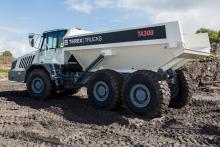Using state-of-the-art technology to create optimum quarry haul roads is an attractive option for aggregates processing operations looking at ways of improving their production efficiency. Guy Woodford reports in our sister title Aggregates Business.
Hul road specialist Proof Engineers has developed an advanced road-building program using the latest technology to design and construct haul roads that can handle high volumes of heavy quarry, mine, large civil construction and earthmoving site vehicle traffic and withstand weather erosion. Proof Engineers’ Haul Road Development Program (HRDP) focuses on innovative practices to produce durable, high-quality roads that reduce maintenance costs, while improving operating speeds and wet weather recovery.
The cutting-edge program encompasses all aspects of building haul roads, from site analysis and resource evaluation through to material selection, training and maintenance monitoring. Proof Engineers is an Australian-based company that utilises state-of-the-art technology to deliver road engineering of a superior standard on a global scale.
Specialising in haul road performance and optimisation, Proof Engineers improves sites’ operational efficiencies specifically through haul road design, construction management, maintenance programmes and monitoring solutions.
Sydney, Australia-headquartered Boral, a major international construction materials group, is among those that have been trialling HRDP to assess its impact on haul road driveability and dust levels at several of its work sites.
Proof Engineers’ engineering and technologies manager, Jordan Handel, said the HRDP’s construction methodologies were achieving high-quality roads within their clients’ budget and equipment limitations.
“Our latest design technology is used to construct roads with improved strength, functionality and drainage,” he said.
“Roads developed with HRDP have optimal rolling resistance and require significantly less maintenance, which adds up to considerable savings for our clients.
“Haul roads constructed with our HRDP require up to five times less maintenance compared to a poorly-constructed haul road.”
HRDP consists of four essential steps in order to achieve quality roads within a quarry, mine, large civil construction or earthmoving site’s operation budget and equipment limitations.
The first step is a full site evaluation, focusing on meteorological and environmental conditions that will impact design and construction, as well as the available resources to determine if the site has adequate equipment, raw materials and local skills, or if outside resources are required. Step two of HRDP evaluates and analyses all design parameters and utilises innovative technology to generate a mechanistic design that considers the selected materials and site-specific traffic conditions.
In this step, Proof Engineers considers the use of stabilisation products such as polymer additives, hydrated lime and bitumen emulsions to improve the quality of local materials in order to reduce costs.
The third step of HRDP is the construction phase: a site-tailored process involving drainage and compaction as well as the training of site personnel.
Step four involves ongoing maintenance to ensure haul roads are operating at a high level, with continuous training of site personnel to ensure roads are correctly maintained and not further damaged in the long term.
“The HRDP was developed by Proof Engineers on the premise that proper construction of quality haul roads will significantly reduce a mine site’s maintenance costs as well as decrease production cycle times,” Handel added.
“The program involves all aspects of haul road construction with a focus on material selection and construction methodologies that meet the highest standards based on optimum engineering properties such as functionality and strength.”
Proof Engineers has developed state-of-the-art road condition monitor (RCM) and dust monitor (Dustective) systems for quarry and mining operators to observe road conditions, prioritise maintenance works, improve operational efficiencies and reduce production cycle times.
The Proof Engineers’ team has a broad range of skill sets from practical, hands-on site personnel to research and design engineers, with experience in the civil and mining industries as owners, contractors and consultants.
Gallagher Aggregates has invested in two Volvo A60H articulated haulers as its prime movers for hauling Kentish Ragstone at its Hermitage Quarry near Maidstone in Kent, Southeast England.
Following an initial enquiry made at last year’s Hillhead exhibition near Buxton in Derbyshire, central England, the 55-tonne capacity A60H was trialled by Gallagher Aggregates to assess the suitability of introducing an articulated hauler of this size to the Hermitage site. “We were impressed with the tonnage moved for a very economical fuel burn, together with fast cycle times,” said Gallagher Aggregates’ operations manager, Pat Gooney. “It certainly proved to be a success in all areas of the quarry’s production and was an immediate hit with our operators. The two new trucks are carrying out the same production as the three 50-tonne trucks they replace, and we are already seeing the immediate benefits when it comes to fuel consumption and the savings on running costs, whilst maintaining the production we require.”
Tailored to Gallagher Aggregates’ needs, the two A60Hs have had additional features fitted to them including 200mm side extensions coupled to a cantilever tailgate, increasing the hauler’s body capacity to 39m³ and maximising payload. To give extra protection to the hitch area and cab, optional front spill guards have been added to the front of the skips. This configuration allows the trucks to handle all on-site duties, which include hauling blasted material from the face to the primary crusher, along with some secondary duties around the plant. Working ten-hour shifts Monday to Friday, with half a day on Saturday, the two new A60Hs will contribute to the annual output of the quarry.
“Again, we are really impressed with the power of the trucks, especially on the gradients with the typical payloads they are carrying” said Gooney. “The new arrivals are proving very popular with their operators too. The cab is extremely comfortable and has been well thought out in its design. The two-speed reverse and fast tip and lower functions add to the overall faster cycle times, and Volvo’s unique suspension system provides excellent load retention and operator comfort.”
Terex Trucks’ northern Germany dealer, Maschinenbau Rehnen, recently exhibited an updated TA300 articulated hauler at the NordBau construction exhibition in Neumünster, a city in northern Germany.
Speaking ahead of the showpiece event staged 11-15 September, Marcel Wimker, machine sales leader at Maschinenbau Rehnen, said: “Terex Trucks’ TA300 is an eye-catcher and last year we had a lot of interest in this robust and reliable articulated hauler. Visitors typically want to see the TA300 up close and sit in the cab to get a better feel for the machine. This usually plays a decisive part in the buying decision.”
Maschinenbau Rehnen became an official Terex Trucks dealer in Q4 2018. Wimker continued: “From the feedback we’ve received so far, our customers are incredibly happy with the machines because they are so reliable – that’s why customers who’ve owned or operated a Terex Trucks articulated hauler before are loyal to the brand and make repeat purchases. They know that the brand stands for great performance, quality and low total cost of ownership. We currently have six TA300 articulated haulers, four are rented out with customers and two are reserved and will be with customers shortly.”
Since August 2018, the TA300 has incorporated the new transmission which comes with two additional forward gears – eight in total – as well as four reverse gears. This helps to ensure smoother gear shifting and thereby superior operator comfort. In addition to this, the TA300 now delivers a 5% improvement against its predecessor in fuel efficiency, as well as enhanced performance and productivity. It also now comes with long-life transmission fluid which has helped to increase the length of time between oil maintenance intervals from 1,000 to 4,000 hours.
The hauler’s maximum speed has also increased to 55 km/h, up from 50 km/h. Ultimately, this means that customers can achieve faster cycle times, reduce the cost of operation per tonne and minimise their fuel consumption.









